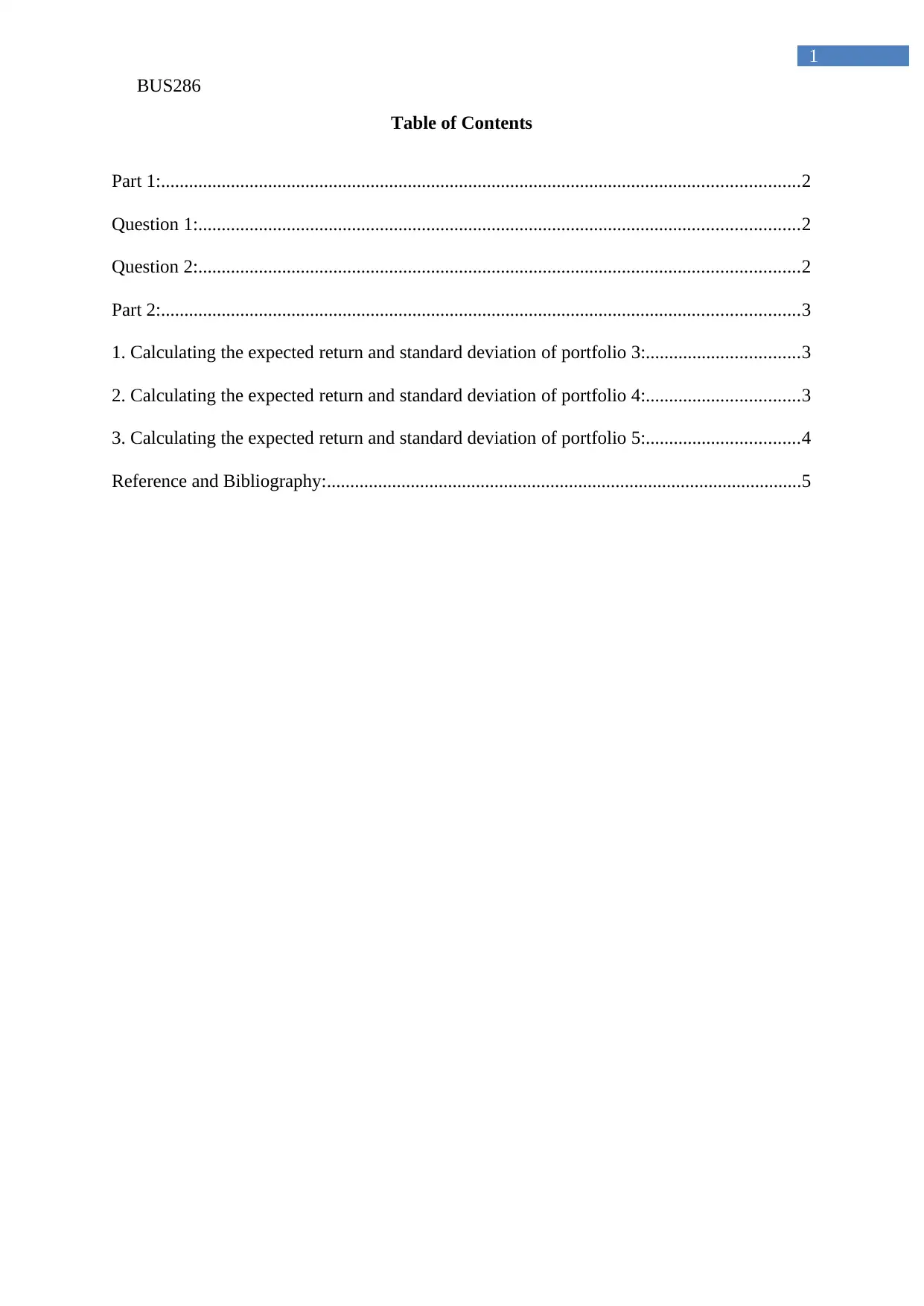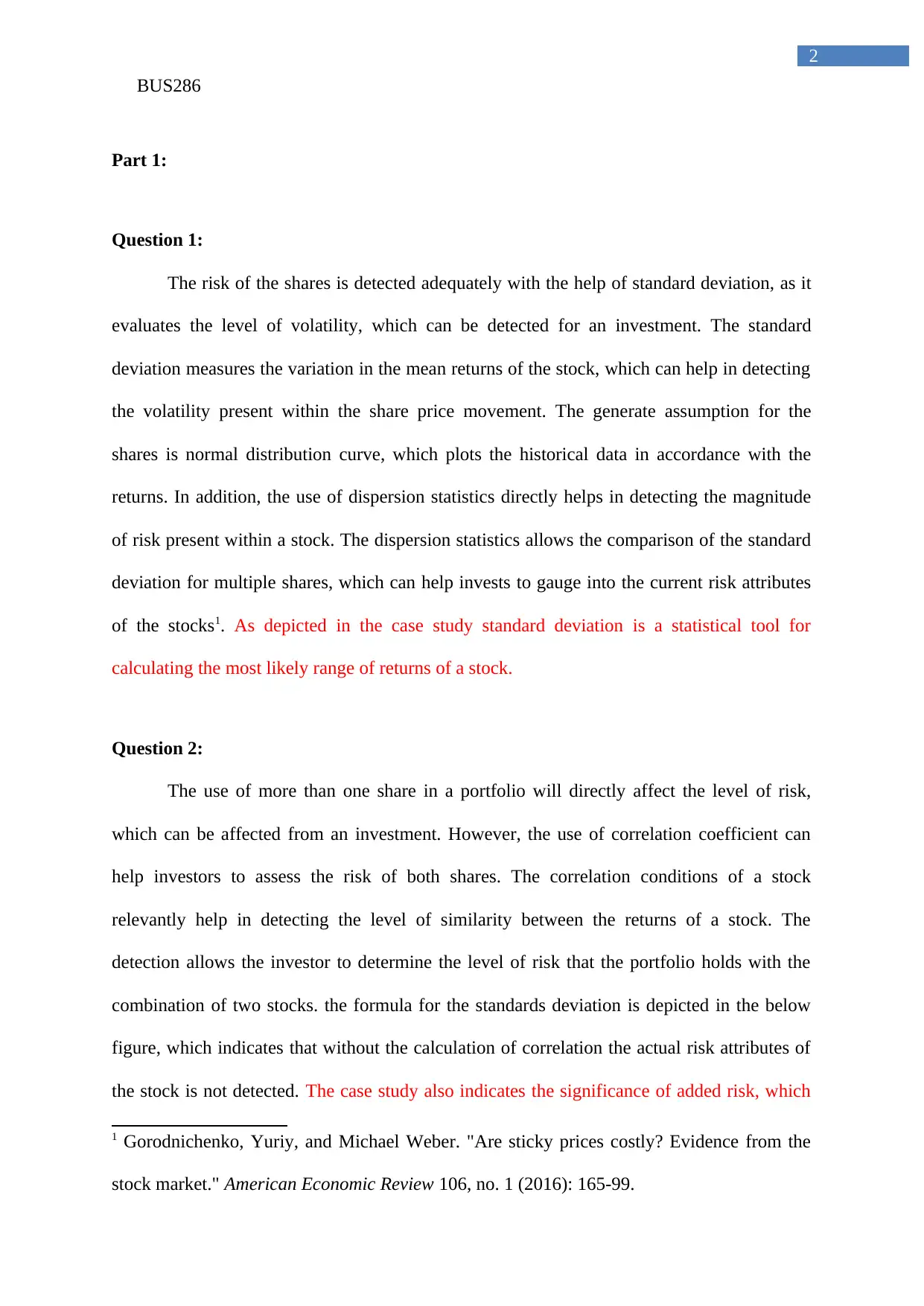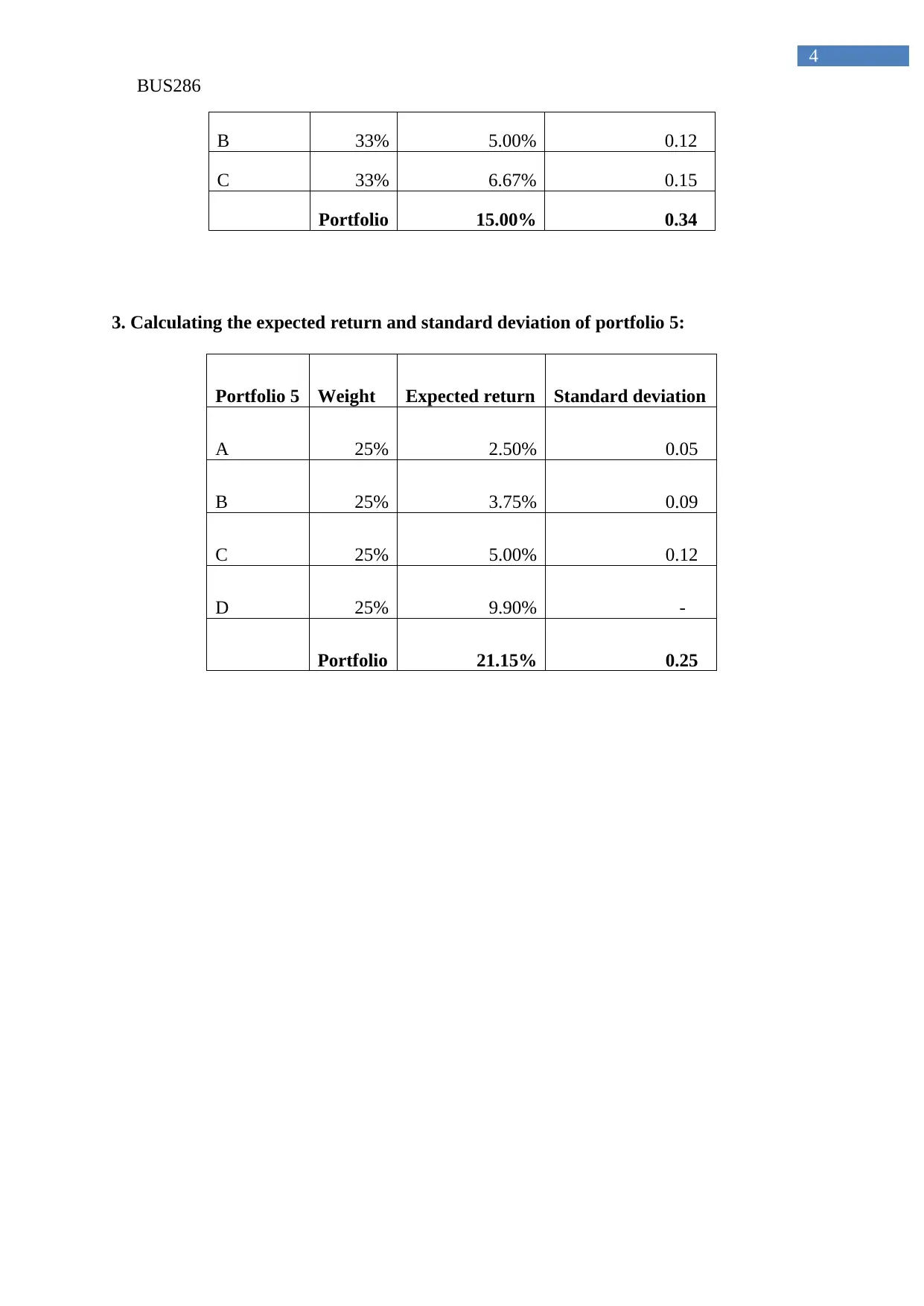BUS286 Corporate Finance: Risk, Return, and Portfolio Diversification
VerifiedAdded on 2023/06/04
|6
|784
|128
Report
AI Summary
This report provides a comprehensive analysis of risk and return concepts in corporate finance, particularly within the context of investment portfolios. It addresses how standard deviation is used to assess the risk of shares and how correlation coefficients help in understanding the risk associated with combining multiple shares in a portfolio. The report includes calculations of expected return and standard deviation for various portfolios, demonstrating the impact of different asset allocations on overall portfolio risk and return. Key concepts such as the normal distribution curve and dispersion statistics are discussed to provide a deeper understanding of risk assessment in investment decisions. The document is available on Desklib, a platform offering a wide range of study resources for students.

Running head: BUS286
BUS286
Name of the Student:
Name of the University:
Authors Note:
BUS286
Name of the Student:
Name of the University:
Authors Note:
Paraphrase This Document
Need a fresh take? Get an instant paraphrase of this document with our AI Paraphraser

BUS286
1
Table of Contents
Part 1:.........................................................................................................................................2
Question 1:.................................................................................................................................2
Question 2:.................................................................................................................................2
Part 2:.........................................................................................................................................3
1. Calculating the expected return and standard deviation of portfolio 3:.................................3
2. Calculating the expected return and standard deviation of portfolio 4:.................................3
3. Calculating the expected return and standard deviation of portfolio 5:.................................4
Reference and Bibliography:......................................................................................................5
1
Table of Contents
Part 1:.........................................................................................................................................2
Question 1:.................................................................................................................................2
Question 2:.................................................................................................................................2
Part 2:.........................................................................................................................................3
1. Calculating the expected return and standard deviation of portfolio 3:.................................3
2. Calculating the expected return and standard deviation of portfolio 4:.................................3
3. Calculating the expected return and standard deviation of portfolio 5:.................................4
Reference and Bibliography:......................................................................................................5

BUS286
2
Part 1:
Question 1:
The risk of the shares is detected adequately with the help of standard deviation, as it
evaluates the level of volatility, which can be detected for an investment. The standard
deviation measures the variation in the mean returns of the stock, which can help in detecting
the volatility present within the share price movement. The generate assumption for the
shares is normal distribution curve, which plots the historical data in accordance with the
returns. In addition, the use of dispersion statistics directly helps in detecting the magnitude
of risk present within a stock. The dispersion statistics allows the comparison of the standard
deviation for multiple shares, which can help invests to gauge into the current risk attributes
of the stocks1. As depicted in the case study standard deviation is a statistical tool for
calculating the most likely range of returns of a stock.
Question 2:
The use of more than one share in a portfolio will directly affect the level of risk,
which can be affected from an investment. However, the use of correlation coefficient can
help investors to assess the risk of both shares. The correlation conditions of a stock
relevantly help in detecting the level of similarity between the returns of a stock. The
detection allows the investor to determine the level of risk that the portfolio holds with the
combination of two stocks. the formula for the standards deviation is depicted in the below
figure, which indicates that without the calculation of correlation the actual risk attributes of
the stock is not detected. The case study also indicates the significance of added risk, which
1 Gorodnichenko, Yuriy, and Michael Weber. "Are sticky prices costly? Evidence from the
stock market." American Economic Review 106, no. 1 (2016): 165-99.
2
Part 1:
Question 1:
The risk of the shares is detected adequately with the help of standard deviation, as it
evaluates the level of volatility, which can be detected for an investment. The standard
deviation measures the variation in the mean returns of the stock, which can help in detecting
the volatility present within the share price movement. The generate assumption for the
shares is normal distribution curve, which plots the historical data in accordance with the
returns. In addition, the use of dispersion statistics directly helps in detecting the magnitude
of risk present within a stock. The dispersion statistics allows the comparison of the standard
deviation for multiple shares, which can help invests to gauge into the current risk attributes
of the stocks1. As depicted in the case study standard deviation is a statistical tool for
calculating the most likely range of returns of a stock.
Question 2:
The use of more than one share in a portfolio will directly affect the level of risk,
which can be affected from an investment. However, the use of correlation coefficient can
help investors to assess the risk of both shares. The correlation conditions of a stock
relevantly help in detecting the level of similarity between the returns of a stock. The
detection allows the investor to determine the level of risk that the portfolio holds with the
combination of two stocks. the formula for the standards deviation is depicted in the below
figure, which indicates that without the calculation of correlation the actual risk attributes of
the stock is not detected. The case study also indicates the significance of added risk, which
1 Gorodnichenko, Yuriy, and Michael Weber. "Are sticky prices costly? Evidence from the
stock market." American Economic Review 106, no. 1 (2016): 165-99.
⊘ This is a preview!⊘
Do you want full access?
Subscribe today to unlock all pages.

Trusted by 1+ million students worldwide

BUS286
3
can be used for detecting the possible outcomes of an asset. Lastly, with the combination of
more than one security, investors can reduce the level of risk from investment and generate a
constant return.
Figure 1: Depicting the formula for Standard deviation of two stocks2
Part 2:
1. Calculating the expected return and standard deviation of portfolio 3:
Portfolio 3 Weight Expected return Standard deviation
A 5% 0.50% 0.01
B 75% 11.25% 0.26
C 20% 4.00% 0.09
Portfolio 15.75% 0.37
2. Calculating the expected return and standard deviation of portfolio 4:
Portfolio 4 Weight Expected return Standard deviation
A 33% 3.33% 0.07
2 Adam, Klaus, Albert Marcet, and Juan Pablo Nicolini. "Stock market volatility and
learning." The Journal of Finance 71, no. 1 (2016): 33-82.
3
can be used for detecting the possible outcomes of an asset. Lastly, with the combination of
more than one security, investors can reduce the level of risk from investment and generate a
constant return.
Figure 1: Depicting the formula for Standard deviation of two stocks2
Part 2:
1. Calculating the expected return and standard deviation of portfolio 3:
Portfolio 3 Weight Expected return Standard deviation
A 5% 0.50% 0.01
B 75% 11.25% 0.26
C 20% 4.00% 0.09
Portfolio 15.75% 0.37
2. Calculating the expected return and standard deviation of portfolio 4:
Portfolio 4 Weight Expected return Standard deviation
A 33% 3.33% 0.07
2 Adam, Klaus, Albert Marcet, and Juan Pablo Nicolini. "Stock market volatility and
learning." The Journal of Finance 71, no. 1 (2016): 33-82.
Paraphrase This Document
Need a fresh take? Get an instant paraphrase of this document with our AI Paraphraser

BUS286
4
B 33% 5.00% 0.12
C 33% 6.67% 0.15
Portfolio 15.00% 0.34
3. Calculating the expected return and standard deviation of portfolio 5:
Portfolio 5 Weight Expected return Standard deviation
A 25% 2.50% 0.05
B 25% 3.75% 0.09
C 25% 5.00% 0.12
D 25% 9.90% -
Portfolio 21.15% 0.25
4
B 33% 5.00% 0.12
C 33% 6.67% 0.15
Portfolio 15.00% 0.34
3. Calculating the expected return and standard deviation of portfolio 5:
Portfolio 5 Weight Expected return Standard deviation
A 25% 2.50% 0.05
B 25% 3.75% 0.09
C 25% 5.00% 0.12
D 25% 9.90% -
Portfolio 21.15% 0.25

BUS286
5
Reference and Bibliography:
Adam, Klaus, Albert Marcet, and Juan Pablo Nicolini. "Stock market volatility and
learning." The Journal of Finance 71, no. 1 (2016): 33-82.
Giannetti, Mariassunta, and Tracy Yue Wang. "Corporate scandals and household stock
market participation." The Journal of Finance 71, no. 6 (2016): 2591-2636.
Gorodnichenko, Yuriy, and Michael Weber. "Are sticky prices costly? Evidence from the
stock market." American Economic Review 106, no. 1 (2016): 165-99.
Sornette, Didier. Why stock markets crash: critical events in complex financial systems.
Princeton University Press, 2017.
5
Reference and Bibliography:
Adam, Klaus, Albert Marcet, and Juan Pablo Nicolini. "Stock market volatility and
learning." The Journal of Finance 71, no. 1 (2016): 33-82.
Giannetti, Mariassunta, and Tracy Yue Wang. "Corporate scandals and household stock
market participation." The Journal of Finance 71, no. 6 (2016): 2591-2636.
Gorodnichenko, Yuriy, and Michael Weber. "Are sticky prices costly? Evidence from the
stock market." American Economic Review 106, no. 1 (2016): 165-99.
Sornette, Didier. Why stock markets crash: critical events in complex financial systems.
Princeton University Press, 2017.
⊘ This is a preview!⊘
Do you want full access?
Subscribe today to unlock all pages.

Trusted by 1+ million students worldwide
1 out of 6
Related Documents
Your All-in-One AI-Powered Toolkit for Academic Success.
+13062052269
info@desklib.com
Available 24*7 on WhatsApp / Email
![[object Object]](/_next/static/media/star-bottom.7253800d.svg)
Unlock your academic potential
Copyright © 2020–2026 A2Z Services. All Rights Reserved. Developed and managed by ZUCOL.





